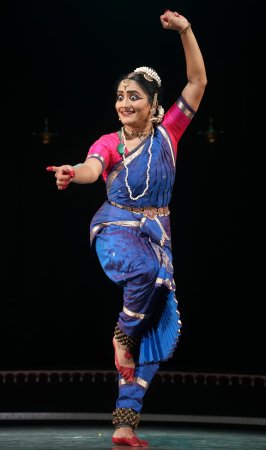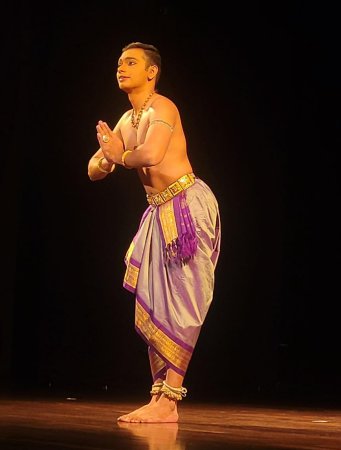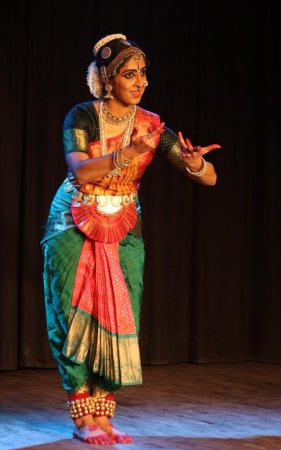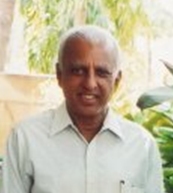
|   |

|   |
Delightful solo dance performances - Satish Suri email: satishism@yahoo.co.in February 11, 2024 Nagaranjitha S in 'Manavi' Photo: Prof.K.S.Krishnamurthy A senior disciple of the late Guru Bhanumathi, Nagaranjitha S. presented a Bharatanatyam recital titled 'Manavi' at ADA Rangamandira on January 26. She started with a tribute to Lord Ganesha through the composition "Sri Maha Ganapathim Avathumam" by Muthuswamy Dikshitar, displaying elegant movements that explored various aspects of the god.  Nagaranjitha S She then performed the composition of Basavanna, "Naada priya Shiva" in the Hamsanandi raga, acknowledging the choreography by Guru Bhanumathi. The rendition narrated the poet's portrayal of Ravana's downfall despite being known as 'Naada Priya Ravana'. Similarly, the poet mentions that Veda Priya Brahma lost one head due to ahankara (ego) and emphasized Shiva's appreciation of true devotion. The devotion of Kannappa, who sacrificed his eyes to Shiva was highlighted, adding richness to the story. The varnam "Simhavahini Sri Rajarajeshwari" is a musical composition by Madurai R Muralidharan in raga Ranjini and adi tala. It praises the supreme goddess who rides on a lion and captivates the mind of Lord Nataraja. The choreography by Sheela Chandrasekhar showcased the different aspects of the goddess through the elegant and expressive dance of Nagaranjitha. The rhythmic patterns were well synchronized with the music and the lyrics, creating a harmonious and aesthetic performance. The charanam "Omkara naada maya roopini Nataraja manohari" depicted the goddess as the embodiment of the primordial sound and the enchantress of the Lord of Dance, with majestic and fluid movements. The artiste presented a Kannada javali by Sheela Chandrasekhar, titled "Mathadu baradeno," in which a Nayika implores her Lord to break his silence. The Nayika wonders if she has done anything wrong to upset him and asks for his forgiveness. She recalls the happy moments they shared in the past and tries to persuade him to reconcile with her. The raga Khamas enhanced the emotional intensity of the composition, which allowed the artiste to convey the sequential beauty of the piece. The Purandaradasa composition "Kadagola taarenna chinnave" highlighted the vatsalya bhava (maternal love) of the mother as she pleads with little Krishna to return the butter churning stick so that she can churn and give him butter. She cajoles him through expressions of love and compassion. The choreography by Guru Bhanumathi provided the scope for an impressive rendition, underscored by the subtlety of expression. She concluded her performance by presenting "Kaadiruvalu Shabari," a composition by the poet V. Sitaramiah, which portrays Shabari, a significant character in the Ramayana, and her interaction with Lord Rama. The portrayal explains how Shabari, a devotee of Rama, lived in the ashram of Rishi Matanga for many years. She followed his teachings and waited patiently for the arrival of Rama, who would grant her liberation from the cycle of birth and death. This rendition captures a poignant moment in the narrative, depicting Shabari offering berries to Rama. The physical portrayal of an elderly woman, eyes filled with tears, along with her humility and adoration, became a powerful symbol of devotion and selflessness. The performance was enriched by the musical accompaniment. D.S.Srivatsa lent his voice to the songs, Sheela Chandrasekhar controlled the rhythm with the nattuvangam, Narasimha Murthy played the melodious flute, Narayanaswamy handled the mridangam with skill and Prashanth Rudrapatna created the mood with the veena. D Dilip in 'Kamakshim Kalayami' Photo: Bangalore International Centre Kuchipudi dancer D. Dilip, disciple of Guru Sailaja, presented a solo performance on 29th January at the Bangalore International Centre, based on the legend of Goddess Kamakshi. The dance depicts how Kamakshi defeats Bhandasura, a demon who represents the five vices of lust, anger, greed, attachment, and ego. The dance also explores the spiritual significance of Kamakshi as the supreme power who liberates humans from these vices. The dance uses verses from holy scriptures such as Sri Lalitha Sahasranama, Soundarya Lahiri, Mooka Panchastithi, Rajarajeswari Choornika, and Kamakshi Suprabatham.  D Dilip The initial segment of the performance portrayed Goddess Kamakshi residing at Srinagar on Mount Meru, with the great lotus serving as her abode. The narrative emphasizes the journey of Kundalini energy through the chakras, ultimately blossoming into the 1000-petalled lotus at Sahasrara. The offering of everything to the goddess was highlighted, accompanied by a Pushpanjali that described Srinagar and followed by a Suprabatham, serving as an awakening ritual for the goddess. The story of how Lord Shiva destroyed Manmatha, the god of love, with his third eye was portrayed in the 'Manmatha Dahanam' segment. The dancer used vivid expressions and movements to convey the emotions of the characters. Manmatha had disturbed Shiva's yogic meditation by shooting an arrow of love at him. He did this on behalf of the Devas, who wanted Shiva to marry Parvati and produce a son who could defeat the demon Tarakasura, who had obtained a boon from Lord Brahma that made him invulnerable to anyone except Shiva's son. He had caused chaos and suffering in the world, and the gods were helpless against him. The Devas hoped that by awakening Shiva's love for Parvati, they could end Tarakasura's tyranny. However, Shiva was enraged by Manmatha's interference and burned him to ashes with his third eye. But destiny had other plans, because with a twist of fate, what Shiva intended to annihilate resurrected and ended up as Bhanda, an asura born out of the anger of Shiva and who tormented the devas through a boon he received as a blessing from Brahma. This segment narrated how Kamakshi, also known as Lalitha and Rajarajeshwari, emerged from the sacrificial fire of Indra to vanquish Bhandasura. Kamakshi was portrayed as a radiant deity with a golden complexion and four arms, wielding divine chakras such as Pasa and Ankusa in her upper hands. Her lower hands hold a sugarcane bow, and floral arrows, and a crescent moon adorns her forehead. Shiva assumes the form of the captivating Kameswara to wed this divine beauty and their heavenly union was illustrated in this segment. The narrative was embellished with vivid descriptions of the goddess's divine qualities and the sacred marriage between Kamakshi and Kameswara. The artiste's hasta abhinaya was exquisite, highlighting the goddess's divine attributes with skill and grace. The climax of the performance was the line "Kanjadalayadakshi Kamakshi", which reveals the goddess's power and compassion. The expressive hand gestures created a captivating portrayal of the goddess's essence. Bhandasura and his 30 sons were slain by the goddess, who then took on a fearsome form. She led a mighty army of elephants and horses, assisted by the ten avatars (Dasavataras) of Vishnu and Shiva. She displayed her strength and glory in rescuing the Devas from their plight, demonstrating her role as the guardian of the cosmic order. Dilip used dynamic movements and gestures to skillfully depict the emotions of the characters in a refined and subtle way. This technique created a vivid and realistic representation of the characters, engaging the audience and arousing empathy for the story. The performance reached its conclusion with Dilip presenting a shloka from each Shatakam of Mooka Panchastithi in Ragamalika. This was followed by a thillana in Hindolam, a composition by Vaidyanatha Iyer in praise of Goddess Kamakshi, and a prayer invoking protection for all her devotees. The story of Goddess Kamakshi was brought to life through the contributions of the following artistes. Dilip - Concept, research, script, dance composition, nattuvangam, extract and narration; Srikanth Gopalakrishnan - Music composition and vocal; Guru Bharadwaj - mridangam, kanjira and jathis; J B Sruthi Sagar - flute ; Anjani Srinivasan - veena; Ganapathi - tabla and damaru; Sumesh - edakka; Jayavigneshwar - mandolin; Saravanan Subramaniam - Sound engineer. Nikhitha Manjunath's exuberant Margam Photo: Aarjith Babu Nikhitha Manjunath, a disciple of Satyanarayana Raju, showcased her skills in Bharatanatyam margam at an event organized by ICCR on the 2nd of February at the Bharatiya Vidya Bhavan, Bangalore. She began with a lively Swarajati that set the mood for the evening, and then moved on to a devotional piece "Innastu bekenne hrudayakke Rama."  Nikhitha Manjunath The highlight of her presentation was the varnam "Sri Krishna Kamalanatho," a composition by Tirumale Srinivas in Reetigowla and adi tala, performed with confidence and vivacity by Nikhitha. The varnam beautifully introduces various avatars of Krishna, leading up to the manifestation of the Viswaroopa Darshan during the Geetopadesam. Nikhitha's high-energy performance was characterized by exquisite choreography, precise dance movements, and jathis accompanied by Chaitra's nattuvangam. Episodes such as the annihilation of Poothana, the destruction of Shakatasura, and Krishna being carried away by Vasudeva after his birth in Kamsa's prison were vividly portrayed through expressive sancharis. The charanam "Gopa gopi swaro gopi surya koti samaprabha" featured elaborate choreography with complex rhythmic patterns and fast-paced footwork, demonstrating precision and stamina gained through extensive training under her guru. The javali that followed inspired by Dharmapuri Subbaraya Iyer's "Parulenna maata," delves into a roller coaster of emotions experienced by the protagonist upon discovering her Lord's tired countenance. She expresses concerns that he may be concealing something from her or that he has succumbed to the charms of another woman. Before allowing her beloved to enter the house, she extracts a promise from him not to heed the words of others. Nikhitha concluded the performance with a thillana, a composition of Dr Balamuralikrishna, a lively and celebratory piece characterized by joy, exuberance, and grace. The thillana showcased crisp nritta and intricate footwork, adding a vibrant and energetic finale to the presentation. The proficient team of musicians, including Chaitra Jagadeesh on nattuvangam, Sangeeth MT on vocals, Vidyashankar on mridangam, and Karthik Sathavalli on flute, added brilliance to the presentation with their musical accompaniment.  Bangalore based Satish Suri is an avid dance rasika besides being a life member of the Music and Arts Society. |